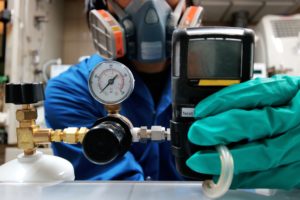
Fixed and portable gas detection equipment is crucial in maintaining the health and safety of working, protecting other equipment, and meeting OSHA and EPA regulations. While both effectively perform the same task, they’re better-suited for specific purposes. When determining which system to use, you should take into consideration these factors:
- The environment of the site
- Typical occupancy of the site
- The gas sources
- Whether the gas is transitory or permanent
- The degree of risk to workers
- Practicality and cost expense of systems
Fixed Gas Detectors
Fixed gas detectors are typically used in extensive facilities to detect large leaks and monitor for gas leaking from a system or storage container. Often installed in key locations, they monitor areas where hazardous gases are likely to accumulate. However, they only detect gases at a primary sampling point, meaning that they are not as flexible if a leak happens outside of their pre-determined monitoring location. Since they monitor these locations 24/7, these systems require a main, consistent power supply.
Fixed detection systems are outfitted with relays and alarm point settings to provide an automatic response upon exposure to hazardous gases. These relays allow the system to enact essential functions—opening/closing ventilation and exhaust fans, triggering alarms, and closing electric valves—to contain leaks and save lives.
Portable Gas Detectors
Portable gas detection monitors are compact, hand-held devices assigned to individual workers to monitor the breathing area around them. Each worker must have the training to use these pieces of equipment properly. Portable units require a battery that must be charged before each use and have to warm up each time they’re turned on.
Due to their light weight and small size, these devices are often used to detect hazardous gases in confined, difficult-to-reach areas unsuitable for fixed detectors. However, unlike fixed detectors, portable units don’t provide an automatic response, which leaves the operator to act in the event of a leak.
For optimal gas detection and protection, you can use these two systems together.







